At ClickerExpo last season, Karen Pryor talked about paired or "opposite" cues, and gave the "bark/be quiet" pair as an example. This is an easy pair to train as a demonstration if you happen to have a very barky dog handy. The concept of teaching cues in pairs is new to many dog trainers, although a familiar tool to some marine mammal trainers. (Learn more at Karen Pryor's courses on cueing at ClickerExpo.)
Subsequently, a discussion about this procedure took place on one of the e-mail discussion lists. Karen was invited to contribute a written comment on how to train "bark/be quiet" as a pair: here is her explanation, along with some comments by other participants in the online discussion.
Karen writes: Let us assume the dog is already barking. (If you want to provoke the barking you can knock on a nearby door or table; that will usually set off a barker). You click, give a treat, and as the dog is swallowing, you startle the dog a little by making a "stop" hand signal in front of its face (or any other signal, I just chose that one.) The dog will react with a little sign of surprise: maybe an anxious look, maybe a slight calming signal such as a head turn. In any case, the instant you've shoved your hand at it you click and again treat. (Treats are in the clicker hand, for this stunt.) The dog eats the treat. Now you wait (or knock on the door if you need to), the dog barks, click/treat, hand gesture, dog looks at hand or looks away but is not barking in that instant; click/treat. Repeat.
What's happening here is: you are provoking the bark (or the dog is barking spontaneously, better yet), and reinforcing it. You are provoking another behavior, and reinforcing it. There are no cues established yet, just two opposite behaviors that you are clicking and treating alternately. Now, this is NOT a pair consisting of barking and the absence of barking. I don't believe you can train the absence of something, in dogs...perhaps in people. The little flinch or reaction you got at first is the behavior you are reinforcing. The dog perceives it as "close my mouth," or "turn my head" (with mouth closed as part of it) or "duck" or "look worried" or whatever it is doing. But it definitely is doing something, and you a clicking that something.
Helix Fairweather, commenting online: You are essentially training and adding a cue to two behaviors at once.
Karen: Yes. And as soon as the two behaviors begin to look the least little bit "operant" to me, that is, I see the dog beginning to do them with some awareness, THEN I will add a verbal cue to the bark ("bark!") and use the hand signal no longer startlingly in the dog's face as a prompt but further away, as a cue for "mouth shut," meanwhile shaping slightly longer "mouth shut" duration as I go.
The next thing that happens is that the dog becomes aware of the bark, and starts trying to bark when you say "bark," but other noises come out by mistake sometimes. Click those, any noise will do; the dog usually settles on a single woof. Now I really do have two cues, bark and shut up. Take it on the road, and when it's good everywhere, then you can change the cues to something you like better.
Helix: A knock at the door might be your new cue for "quiet."
Karen: No; I think I would use a word or a gesture to CUE the behavior of "shut mouth" whether there is a knock on the door or not. I want "shut mouth" to be available to me any time, and I need my dogs to bark at the door. I just also need them to be quiet when asked.
Dani Weinberg, commenting online: What am I missing here? Seems to me we do this in obedience when we're teaching directions—either for directed jumping or for gloves.
Karen: Yes, indeed you do. And in agility as well, left and right are common paired cues. But, people sometimes have trouble teaching them, dogs have trouble understanding them, and there is a lot of (in my observation) HUGE cues, involving the whole body, arm, face, voice, etc. There are risks in giving these complex cues. You don't know which part of it the dog is attending to, so it's easy to give the cue "wrong" and mess the dog up, for example. If you refine the cue down to one gesture and/or one word the cue is more consistent and you are protected against superstitious errors. (See Karen Pryor's session at this year's ClickerExpo in Orlando and San Diego, What's So Hard About That? Tackling the "hard" obedience exercises, Friday 3:45-5:15 p.m.)
Karen continues: Left and right are just one example of paired cues that are opposites (indicating two behaviors, not just something that is either present or absent). Here are some others: "come forward/go backward," "Nose/paw" (touch a target with the nose, touch it with the paw), "big/little" (teach the dog to go to a big object and a little object—or a black object and a white object—on two discriminative cues), "spin left/spin right," "over/under" (you can see me working with this pair on the old Clicker Magic tape. Not the greatest but we did get there).
You can train these discriminations rapidly if you train them as opposites; often you can get the behaviors and the cues established in a single session. At ClickerExpo Chicago, Ken Ramirez, director of training at the Shedd Aquarium, told us they routinely use paired cues to give instructions to the dolphins and whales etc. He pointed out that the first pair can be hard to train (that's why competition people can get stuck with left/right problems, I think) but by the time the animal has learned three pairs, it has the "concept" of alternates: Do this on A, do that on B. Then you can teach new pairs really fast. (See Ken Ramirez' session at this year's ClickerExpos, "Did he say left or right?" Modifier cues and how to teach them, Sunday 9 a.m.).
Kay Laurence's students in England train a lot of paired cues to use as parts of other behaviors: useful in designing freestyle routines, in teaching scent exercises, in service work, and in any kind of work at a distance. (See Kay Laurence's sessions at this year's ClickerExpo Orlando and San Diego, Meeting the Challenge: teaching complex and novel behaviors quickly, Friday and Saturday 11:00 a.m. and Pinpointing, Polishing, and Proofing the Shaped Behavior, Sunday 9 a.m.)
Karen continues: If I had competition dogs and wanted them to be fluent in understanding alternative cues, I would clicker train some little "around the house" pairs, such as "backup/come forward." The recipe above for "bark/shut mouth" outlines how the procedure would go for each pair. You would start very close in with very small steps and maybe targeting or other prompts to get the behavior going. (Not luring with food, which is a form of modeling—making the animal move through the behavior, which may actually interfere with the learning.)
I would practice fading out any prompting body English until the dog had the behaviors down pat on a verbal cue and/or a NON-related visual signal (i.e., point up for "go backward," point down for "come forward"). The reason for the NON-related cue is so that YOU don't get superstitious and if the dog makes a mistake, start giving the cue with lots of body English, or "louder." (If the dog makes a mistake, you need to go back and reshape the behavior or the cue a little, not try to make it happen. That will be easier for you to remember if the cue does not relate to the behavior.)
Then by the time I needed the dog to respond to paired cues in an important situation, I would have a dog that understood how to do that.
BTW, Kay Laurence is of the opinion that dogs have trouble hearing the difference between left and right in English. She uses "tick/tock" or "pink/blue" or some other pairing. (Whether this is vital or not it is good for the trainer, too, as being forced to remember something non-obvious helps you to keep your cues consistent and accurate.)
And, if you have a bunch of paired cues that are nice and clean, you can stack them. "Paw" (not nose) "left" (left target, not right) "hard" (not soft) and the dog will go out and tap the left-hand target, of two set up together, hard enough to knock it down. People are doing it with dolphins and horses and birds, a good mind game for trainers as well! Directed jumping, anyone?
So, that's what I meant by paired cues. Not "present/absent" but "do this/do that."




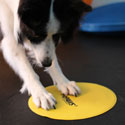
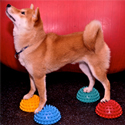
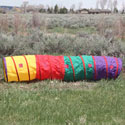
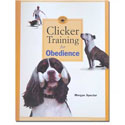

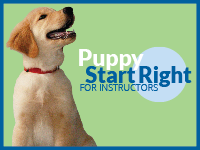
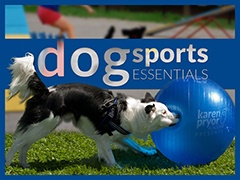
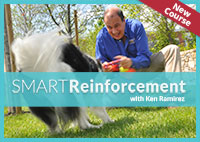

Question on this pair
Early on, I trained my excessive alert-barking dobie mix to "speak" (usually bark once) on a hand signal command, so she can already do this very well - should I cue/reward her for this when I 'catch' her barking and add the "quiet" command, or try to dive in and try to train only the "quiet" cue? I have tried many things in the past - with treats and verbal rewards, but nothing stops her barking for long.
Any suggestions? Thank you for the excellent article.
dog barking
I home board dogs at my residence while their owners go on vacation. Naturally when someone comes to the front door the dogs start barking. I've tried shaking a metal can filled with coins to stop them from barking but it doesn't always work. And often they will start barking again as soon as I stop shaking the can. It has been difficult to talk to the owners about their dog, whether they are arriving with their dog or entering to take their dog home, when the other dogs are all barking. I have my kitchen located to the back of the house where I do 'meet and greets' with prospective clients and sometimes they clearly don't like the barking. The dogs do settle down after a few minutes. Each room on the first floor of my house is enclosed with glass panelled doors so the dogs can be contained in different rooms and so they won't all run toward the front door when the door bell rings. I think their behavior is normal as they want to socialize with people and the 'new' doggy friend coming to my home for a visit. So obviously they are very excited. I just want the noise to stop as quickly as possible and if you have any suggestions on how to 'train' the dogs to not bark when visitors come to my home. Any help is greatly appreciated. Thabk you.
Dianne
Dezzy's Doorstep
www.dezzysdoorstep.net
Helpful links for unwanted barking
Hello Dianne,
You might want to read these articles for some helpful information:
Post new comment